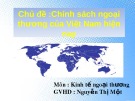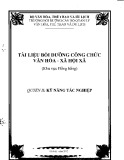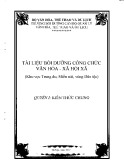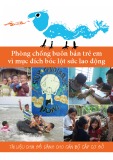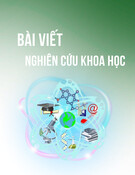
106 Hoa Binh University Journal of Science and Technology - No 14 - 12.2024
MEDICINE
TRADITIONAL MEDICINE TREATMENT IN DERMATOLOGY
Assoc. Prof., Dr. Hoang Minh Chung, Dr. Nghiem Thi Thuy Giang
Hoa Binh University
Corresponding Author: hmchung@daihochoabinh.edu.vn
Received: 17/11/2024
Accepted: 07/12/2024
Published: 24/12/2024
Abstract
Topical medications derived from traditional medicines play a crucial role in dermatological
treatment, often serving as the primary therapeutic approach. The underlying causes of dermatological
conditions may include external factors such as wind, cold, dampness, heat, parasites, or internal
imbalances such as stagnation of qi, blood stasis or deficiencies in liver and kidney function.
Treatment methods in traditional medicine may incorporate remedies, surgical interventions, or a
combination of both. Surgical treatment often involves straightforward techniques such as soaking,
steaming, rubbing... The use of herbal remedies typically has minimal adverse effects while proving
to be effective, and the form of medication are commonly administered without the need for ingestion.
Topical medications based on traditional medicine hold significant promises for development and
substantially to people's health care.
Keywords: Skin diseases, herbal traditional medicine.
Thuốc cổ truyền điều trị bệnh ngoài da
PGS.TS Hoàng Minh Chung, TS. Nghiêm Thị Thùy Giang
Trường Đại học Hòa Bình
Tác giả liên hệ: hmchung@daihochoabinh.edu.vn
Tóm tắt
Thuốc cổ truyền dùng ngoài trong da liễu chiếm một vị trí hết sức quan trọng, trong nhiều
trường hợp là quan trọng nhất. Nguyên nhân có thể do ngoại tà xâm phạm (phong, hàn, thấp, nhiệt,
trùng…) hoặc do khí trệ, huyết ứ hay can thận bất túc mà gây nên. Phương pháp điều trị theo y học
cổ truyền có thể bằng nội khoa, ngoại khoa hoặc kết hợp. Điều trị ngoại khoa với các phương pháp
đơn giản như ngâm, xông, xoa,… Các thảo dược được sử dụng không những không gây tác dụng
phụ, mà hiệu quả lại tốt, dạng thuốc sử dụng rất thông thường, bệnh nhân không phải uống thuốc.
Thuốc cổ truyền dùng ngoài trong bệnh da liễu hứa hẹn sự phát triển và đóng góp nhiều trong chăm
sóc sức khỏe cho người dân.
Từ khóa: Bệnh ngoài da, thuốc cổ truyền.
1. Introduction
Dermatological diseases (dermatology) are
diseases that affect the skin and organs of the
skin. Traditional medicine defines skin diseases as
diseases of epidermis. Traditional medicine used in
dermatology occupies a very important position.
Ancient medical documents have remained
valuable experiences on the pathological,
symptoms and treatment of skin diseases that need
to be inherited and promoted [1].
To treat skin diseases according to modern
medicine as well as according to traditional
medicine or can be combined with internal
medicine and topical medicine or only topical

No 14 - 12.2024 - Hoa Binh University Journal of Science and Technology 107
MEDICINE
medicine. With the advantages of topical
medicine such as local effect; fast; limiting
unwanted effects on other organs... Therefore,
traditional medicine has a certain position in the
treatment of some skin diseases according to
traditional medicine [2].
In this article, we only mention the issue of
skin diseases and the role of drugs used to treat
skin diseases according to traditional medicine.
2. Contents
2.1. Skin diseases according to Traditional
medicine
Causes and Symptoms.
Wind: Wind evil causes skin diseases
with the characteristics of developing quickly,
moving, disappearing quickly, easily spreading
throughout the body causing itchy rashes, red
rash, dry skin, warts. Often combined with
other wind evils as wind-cold, wind-heat, wind-
dampness...
Dampness: caused by external dampness,
often the disease is in the lower part of the body,
easily causing ulcers, long-term recovery.
Heat: caused by external evil or internal
heat. The symptoms often has a swelling, heat,
redness, itching and pain.
Blood stasis: Mostly due to liver qi
stagnation or invasion of external evils causing
qi disorders and blood stasis. Clinical symptoms
often include spots or rashes of blood stasis, the
skin color of the affected area is purple or blue-
purple or the affected skin area is thickened
with nodules.
Blood-deficiency and wind-dry: Due to
long-term illness or due to spleen and stomach
weakness causing blood deficiency, which is
not enough to nourish the skin. The disease
often was long term-recovery, the skin is dry or
thickened, cracked, rough, scaly, itchy.
Liver and kidney deficiency: Due to liver
blood deficiency, the nails are brittle, easily
thickened and dry, causing warts on the skin.
In addition, other causes such as: eating
or contact with toxic substances or due to the
poison of insect bites causing swelling, heat,
pain, itching, rash, red rash, blisters... can have
symptoms locally or throughout the body.
Skin lesions: divided into 2 types.
Primary lesions include rash, papules,
nodules, vesicles, pustules and swelling.
Secondary lesions: scaling, crusting, ulcers,
abrasions, cracks, pigment deposits, buffalo
hump, scars.
In addition to the above causes, skin
diseases are also related to the meridians:
Diseases starting in the upper body and head
due to the 3 yang meridians are mostly caused
by wind-heat, wind-dampness, wind-dampness;
Diseases starting in the middle part of the body
are the liver and gallbladder meridians, mostly
caused by stagnant qi, stagnant fire, damp heat;
diseases starting in the lower part of the body are
the taiyin meridians, mostly caused by damp-
heat, cold-dampness. In addition, if the disease
in the nose, it is related to the lung- meridian;
the disease starting in the lips is related to the
spleen-meridian; the disease starting in the ribs
is related to the liver-meridian and the disease
starting in the perineum is related to the liver
and kidney-meridians. Therefore, depending
on the cause of the disease and the location
of the disease, there are appropriate treatment
methods: systemic treatment (internal medicine)
with oral medication or/and local treatment
(surgery) or topical medication.

108 Hoa Binh University Journal of Science and Technology - No 14 - 12.2024
MEDICINE
2.2. Treatment of Skin Diseases
- Internal medicine:
+ Wind-dispersing cold: to treat hives, lupus
erythematosus... the prescription includes the
following medicinal herbs: Herba Elsholtziae
ciliata, Radix Saposhnikoviae divaricatae, Radix
Bupleuri, Radix Peucedani, Rhizoma et Radix
Notopterigii, Radix Angelicae pubescentis,
Fructus Aurantii, Poria, Radix Platycodi
grandiflori, Rhizoma Ligustici wallichii, Herba
Menthae and Radix Glycyrrhizae.
+ Wind-dispersing heat: treat psoriasis,
rheumatism. Prescription: Tieu phong tan:
Radix Angelicae sinensis, Radix Rhemanniae
glutinosae, Radix Saposhnikoviae divaricatae,
eriostracum Cicadae), Rhizoma Anemarrhenae,
Folium et Ramulus Crotonis tonkinensis, Semen
Sesamum indicum, Herba Elsholtziae ciliata,
Rhizoma Atractylodis, Fructus Arctii lappae,
Gypsum fibrosum, Caulis Akebiae and Radix
Glycyrrhizae….
+ Clearing heat and removing dampness:
Treating eczema, oozing sores, and pus-
filled boils. Using the following herbs: Herba
Adenosmatis caerulei, Fructus Gardeniae,
Rhizoma Rhei hoặc Long đởm tả can thang…
+ Detoxification and Activating Blood
Circulation Decoction: to treat dermatitis
caused by drug allergies and psoriasis. The
prescription used is Hoang Lien Giai Doc.
Cortex Phellodendri, Rhizoma Coptidis, Radix
Scutellariae, Fructus Gardeniae …
Blood circulation and stasis removal: to
treat erythema nodosum, scleroderma... The
prescription uses “Tu Vat Dao Hong” or “Huyet
Phu Truc U thang”.
+ The wind blows down the can: to treat
itching in the elderly, warts, shingles... The
medicine uses Gastrodia elata.
+ Nourishing blood and moistening
dryness: to treat neurodermatitis, and eczema.
The prescription uses Si Wu Tang Jia Wei or
Dang Gui Yin Zi.
- Surgical treatment (Topical medications)
It is a method used with different types of
medications to treat the damaged skin area locally.
Commonly used topical medications include:
Liquid medicine: a liquid medicine prepared
from one or more herbs by boiling or steeping in
clean water for soaking, washing or applying.
Effects: Clearing heat and detoxifying, reducing
swelling, cleaning wounds, disinfecting, and
relieving itching. Commonly used herbs include:
Cortex Phellodendri, Herba Portulacae, folium
Piper betlae, Galla chinensis, Herba Camellia
sinensis, Herba Elsholtziae ciliata…
Starch soluble: the ingredient is powdered
medicine mixed in water. Anti-inflammatory,
skin protection, anti-itching effects... treating
acute dermatitis, rash... paste, Tam Hoang
formular medicine
Powdered medicine: to rub on rashes,
itchy rashes, between toes... The medicinal
ingredients used are: Kali alum, Power Indigo
pulveratae …
Elixirs: Common herbs such as Radix
Stemonaceae, Radix Angeliae dahuricae, Radix
et Rhizoma Asari … soaked in alcohol to apply
on skin or mucous membranes. Used to treat
nail fungus, ringworm, neurodermatitis…
Semi-solid extracts: From liquid medicine,
it can be condensed to a certain physical state.
Then add vegetable oil or vaseline or beeswax
to make ointments, pastes, creams, gels to
apply in the skin. These medicines are used for
chronic dermatitis with scales, cracked, chapped

No 14 - 12.2024 - Hoa Binh University Journal of Science and Technology 109
MEDICINE
skin, ulcers, eczema, etc. Medicines are These
drugs are absorbed by two mechanisms: First
is absorption through the meridians because
the meridians are a part of the human body that
connects the exterior, interior, left and right
parts of the body; on the outside, it is related
to the skin, on the inside, it is connected to the
internal organs; forming a network throughout
the body. Medicines that are applied/patched to
acupoints can work through the meridians. For
example: applying medicine to the navel can
work through the Shenque point, then through
the meridian system to the whole body. The
second mechanism absorbs through the skin. For
topical medications using traditional medicines
treatment for dermatology, after pasted, steamed,
soaked, etc., the medicinal substances will be
diffused into the skin and then go inside through
the following: directly penetrating the epidermis,
penetrating the hair follicles, penetrating the fat
glands and being absorbed by the blood vessels
and vascular network.
Principles of Topical Dermatologic Therapy:
The effect of topical dermatologic therapy
depends not only on the properties of the drug,
dosage, concentration, method of preparation,
dosage form, etc., but also on the disease.
Therefore, when using topical dermatologic
therapy, you should notice that: The choice
of medicine should be based on a comparison
between the characteristics of disease and the
properties of medicine. If the cause of the disease
is clear, then choose the medicine based on the
cause (skin diseases caused by pus-producing
bacteria should choose antipyretic and antiseptic
drugs such as Cortex Phellodendri, Radix
Scutellariae, Radix Lethospermi; Treatment
of skin itching: Herba Piperis lolot, Herba
Wedeliae, Herba Artemisiae vulgaris, Herba
Eleusinis indicae, Herba Centellae asiaticae,
Herba Elsholtziae ciliata; Dermatologists treat
atopic dermatitis with Folium Polysciacis, Herba
Piper betl, Folium Averrhoa carambolae. chữa
nấm da dùng olium Polysciacis), Aloe, Herba
Camellia sinensis. Or choose the medicine
based on the characteristics of the skin lesions.
If congested skin lesions cause inflammation
and are accompanied by ulcers and exudation,
use heat-clearing and astringent drugs such as
Radix et Rhizoma Gentianae, Galla chinensis,
Folium et Ramulus Crotonis tonkinensis. If the
skin is thick, rough, or nickel-like, you should
use nourishing yin, and anti-itching medications
such as Radix Angelicae sinensis, Semen Kochia
scoparia, esame oil, Cocuonut oil. The itching
can use anti-itch drugs such as Folium et lignum
Cinnamomi camphorae, Herba Menthae,
Borneol, Fructus Xanthii strumarii…. Choosing
the form of the drug: success or failure of topical
drugs is not only by choosing the right medicine
but also by choosing the right form of the drug.
Choosing the wrong form of the drug not only
reduces the effectiveness of the drug but can
also make the condition worse (for example,
using ointment in cases of ulcers and secretions).
The principle of choosing the form of the drug
is: skin lesions that have not caused scratches
(erythema, papules,) use powder, or liquid
medicine. Urticaria (liquid medicine, medicinal
wine). Ulcerative lesions, secretions, blisters, and
pustules should be applied to embalming fluid,
liquid, and oil medicine. Skin lesions with cracks
and scabs should be ointment, oil medicine, soft
paste... However, in the process of treating skin
lesions constantly changing, the form of the drug
also needs to be changed accordingly.

110 Hoa Binh University Journal of Science and Technology - No 14 - 12.2024
MEDICINE
3. Drug Delivery Methods
3.1. Steaming Traditional Medicine
Treatment applications: Colds, allergies,
eczema/dermatitis. Rheumatism, peripheral
nerve pain... The drug group often used in the
dispersed wind and cold, remove cold) with
essential oils; drugs that produce new blood as:
Folium Perirllae frutescensis, Cymbopogon
nardus, Herba Ocimi tenuiflori, Herba
Elshohziae ciriatae, Folium Bambusae, Herba
Artemisiae vulgaris…
3.2. Herbal Baths
Herbs are often used with an astringent taste
and antibacterial effect (astringent taste (wax),
heat-clearing and detoxifying and dampness)
to treat scabies, and chickenpox as: Herba
Centipeda minima, Herba Ecliptae, Herba
Centellae asiaticae.
3.3. Cataplasma and Apply Medicine
To use in cases of: sprains, dislocations, soft
tissue injuries, rheumatism, abdominal pain...
Shingles treatment with soft plaster includes:
Rhizoma Rhei, Rhizoma Coptidis, Galla
chinensis or powder (Semen Arecae catechu,
Rhizoma Atractylodis and Cortex Phellodendri
100g each) to treat eczema, dermatitis. to To
apply oil of Radix Lethospermi , Borneol, Flos
Lonicera japonicae, Radix Angenica Dahuricae
to treat psoriasis, dermatitis, eczema...
3.4. Mouthwash
To use the medicinal herbs as: Radix
Angelicae dahuricae, Radix et Rhizoma
Asarum, Radix et rhizoma Clematidis, Herba
Piperis lolot…. An herbal decoction to hold in
mouth when toothache.
3.5. Massage Method
To treat rheumatism and trauma. Using
the alcohol/tincture of Radix Aconiti, Semen
Strychni, Semen Momordicae cochinchinensis
with alcohol/tincture. To rub on the painful area.
4. Discussions
The skin is the largest organ of the body,
including the epidermis and the dermis. Skin
provides protection and acts as a barrier against
external menaces like allergens, chemicals,
systemic toxicity, and infectious organisms.
Skin disorders like cancer, dermatitis, psoriasis,
wounds, skin aging, acne, and skin infection
occur frequently and can impact human life [2].
Dermatological disorders are among the
most common human diseases, and almost
everyone has at least one dermatological disease.
Although people's knowledge about skin care
has improved, common dermatological disease
often confuse people about how to treat prevent.
Dermatological disease are very common in
humans, affecting quality of life, mental health
and productivity. In fact, dermatological disease
are reported to be the fourth leading cause of
non-fatal burden, as indicated by disability-
adjusted life years (DALYs), in addition to the
fact that skin is also the 18th leading cause of
health burden worldwide [3].
In the present, more and more people
with dermatological diseases have chosen
an examination and treatment according to
Traditional Medicine. Because traditional
medicine is a benign herbal medicine, not only
does not cause side effects but also effectively
repels the root cause of the disease, and nourishes
the body, so most patients do not relapse later
by the method of both internal medicine and
surgery (external medicine) or only surgery [4].
Maintaining healthy skin is essential for a
healthy body. The acceptance and recognition
of herbal medicine is increasing day by day.

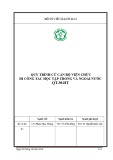
![Tài liệu thi tuyển viên chức năm 2017: Vị trí nghiên cứu viên [Cập nhật mới nhất]](https://cdn.tailieu.vn/images/document/thumbnail/2018/20181114/tiantian2811/135x160/5531542182950.jpg)

